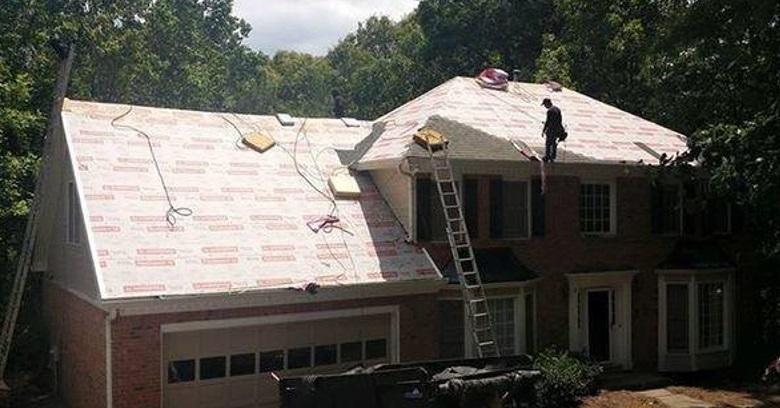
Underlayment is a critical roofing component that works with the top materials to create a breathable, yet watertight roof.
For more than a century, this roofing component was only made from felt in various thicknesses, the thicker and more protective, the better.
Today, roofing underlayment is also available in synthetic varieties.
This brief comparison should help homeowners in need of a new roof installation understand the difference so they can choose the best option for their needs and their budgets.
Felt Roofing Underlayment
Felt roofing underlayment is constructed from layers of fiberglass and/or paper mat that have been saturated with asphalt dust to create a water-resistant barrier that protects the wood decking beneath the exterior roof materials.
- Pros – Felt underlayment is available in two thicknesses, #15 and #30, the latter of which is more durable and protective, but at a slightly higher price. In comparison to synthetic roofing underlayment, felt is very economical and does a reasonably good job when carefully applied.
- Cons – There are a number of issues that homeowners should be aware of when choosing felt roofing underlayment, beginning with the fact that it can be easily torn or damaged. When this happens or if the felt is not properly installed or the roofing materials above it are not properly installed, it can become saturated and contribute to the rotting of the decking material or decomposition of the upper materials. Felt underlayment is heavier per square foot than synthetic and if it absorbs water, it will become even heavier. It can also harbor microorganisms and become a host for mold and algae growth.
Synthetic Roofing Underlayment
Synthetic roofing underlayment is constructed in multiple ways by numerous manufacturers, using woven, spun polymer fibers.
It has been in use for about two decades as a better alternative to the traditional felt underlayment.
- Pros – Synthetic roofing underlayment excels in all the places where felt underlayment can be more challenging. It is stronger and more durable, up to four times lighter, and more protective than felt while being just as breathable and moisture-resistant when correctly applied. In addition, it is easier to apply than felt, will not absorb water, and is resistant to mold and algae growth.
- Cons – The main disadvantage of using synthetic underlayment is its cost. Synthetic products run three to four times the price of most felt underlayment.
Which Is The Better Choice?
Performance-wise, there is no question that synthetic roofing underlayment is the better, more protective product over even the highest quality felt underlayment; however, it can be cost-prohibitive and budget-conscious homeowners frequently still choose felt for this reason.
Felt is still fine in most cases, but careful and appropriate installation is the key.
Also, it is important for homeowners to research their roofing materials warranties, as some materials companies will not warrant their products if felt underlayment is used.
Discuss Roofing Materials with An Experienced Local Roofer
While synthetic roofing underlayment is a preferred product to use when paying for a new roof installation, it is understandable that some homeowners might balk at the high cost.
The best advice for making an informed decision is for homeowners to discuss the options including the advantages and disadvantages of each when installed with the chosen shingles or materials and go from there.
An experienced roofing contractor will help customers make the decisions that work for them.
Need Commercial Roof Damage Repair Services
GMA Restoration Can Fix Commercial Roof Damage Repair
Call 979-356-2392
